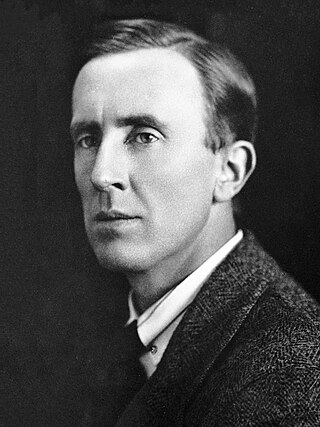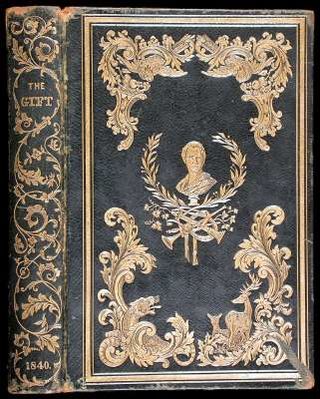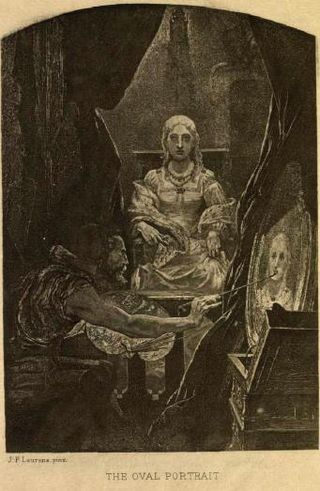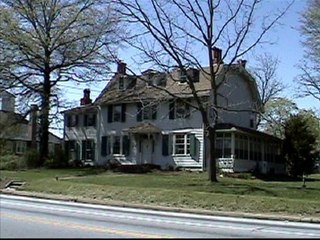
John Ronald Reuel Tolkien was an English writer and philologist. He was the author of the high fantasy works The Hobbit and The Lord of the Rings.
Tolkien fandom is an international, informal community of fans of the works of J. R. R. Tolkien, especially of the Middle-earth legendarium which includes The Hobbit, The Lord of the Rings, and The Silmarillion. The concept of Tolkien fandom as a specific type of fan subculture sprang up in the United States in the 1960s, in the context of the hippie movement, to the dismay of the author, who talked of "my deplorable cultus".

"William Wilson" is a short story by American writer Edgar Allan Poe, first published in 1839 in The Gift, with a setting inspired by Poe's formative years on the outskirts of London. The tale features a doppelgänger. It also appeared in the 1840 collection Tales of the Grotesque and Arabesque, and has been adapted several times.

"The Oval Portrait" is a horror short story by American writer Edgar Allan Poe, involving the disturbing circumstances of a portrait in a château. It is one of his shortest stories, filling only two pages in its initial publication in 1842.

"Ligeia" is an early short story by American writer Edgar Allan Poe, first published in 1838. The story follows an unnamed narrator and his wife Ligeia, a beautiful and intelligent raven-haired woman. She falls ill, composes "The Conqueror Worm", and quotes lines attributed to Joseph Glanvill shortly before dying.

The Darley House, located in Claymont, New Castle County, Delaware, at 3701 Philadelphia Pike, at the intersection of Philadelphia Pike and Darley Road, is the former home of world-renowned illustrator Felix Octavius Carr Darley (1821–1888).

The Penn State University Press, also known as The Pennsylvania State University Press, is a non-profit publisher of scholarly books and journals. Established in 1956, it is the independent publishing branch of the Pennsylvania State University and is a division of the Penn State University Library system.
National Public Radio broadcast a dramatization of J. R. R. Tolkien's The Lord of the Rings in 1979. It was produced by The Mind's Eye. It was produced by Bob Lewis and adapted for radio by Bernard Mayes.
Many adaptations of The Lord of the Rings, an epic by the English author J. R. R. Tolkien, have been made in the media of film, radio, theatre, video games and recorded readings.

"Dr. Heidegger's Experiment" is a short story by American author Nathaniel Hawthorne. The story is about a doctor who claims to have been sent water from the Fountain of Youth. Originally published anonymously in 1837, it was later published in Hawthorne's collection Twice-Told Tales, also in 1837.

Graham's Magazine was a nineteenth-century periodical based in Philadelphia established by George Rex Graham and published from 1840 to 1858. It was alternatively referred to as Graham's Lady's and Gentleman's Magazine, Graham's Magazine of Literature and Art, Graham's American Monthly Magazine of Literature and Art, and Graham's Illustrated Magazine of Literature, Romance, Art, and Fashion.

The Book League of America, Inc. was a US book publisher and mail order book sales club. It was established in 1930, a few years after the Book of the Month Club. Its founder was Lawrence Lamm, previously an editor at Macmillan Inc. The company was located at 100 Fifth Avenue, New York City, New York in a 240,000-square-foot (22,000 m2) office building that was constructed in 1906. It printed and distributed a variety of volumes in the 1920s, 1930s, 1940s, and 1950s. A victim of the Great Depression, the Book League of America was purchased by Doubleday in 1936.
J. R. R. Tolkien's fantasy books on Middle-earth, especially The Lord of the Rings and The Silmarillion, drew on a wide array of influences including language, Christianity, mythology, archaeology, ancient and modern literature, and personal experience. He was inspired primarily by his profession, philology; his work centred on the study of Old English literature, especially Beowulf, and he acknowledged its importance to his writings.

The Edgar Allan Poe Cottage is the former home of American writer Edgar Allan Poe. It is located on Kingsbridge Road and the Grand Concourse in the Fordham neighborhood of the Bronx, New York, a short distance from its original location, and is now in the northern part of Poe Park.

Radio Tales is an American series of radio drama which premiered on National Public Radio on October 29, 1996. This series adapted classic works of American and world literature such as The War of the Worlds, Twenty Thousand Leagues Under the Sea, Beowulf, Gulliver's Travels, and the One Thousand and One Nights. The series was co-produced by Winnie Waldron and Winifred Phillips. Waldron created the series and served as on-air host. Phillips composed music for the series.

Love Letters of Great Men, Vol. 1 is an anthology of romantic letters written by leading male historical figures. The book plays a key role in the plot of the American film Sex and the City.

Middle-earth is the setting of much of the English writer J. R. R. Tolkien's fantasy. The term is equivalent to the Miðgarðr of Norse mythology and Middangeard in Old English works, including Beowulf. Middle-earth is the human-inhabited world, that is, the central continent of the Earth, in Tolkien's imagined mythological past. Tolkien's most widely read works, The Hobbit and The Lord of the Rings, are set entirely in Middle-earth. "Middle-earth" has also become a short-hand term for Tolkien's legendarium, his large body of fantasy writings, and for the entirety of his fictional world.

The works of American author Edgar Allan Poe include many poems, short stories, and one novel. His fiction spans multiple genres, including horror fiction, adventure, science fiction, and detective fiction, a genre he is credited with inventing. These works are generally considered part of the Dark romanticism movement, a literary reaction to Transcendentalism. Poe's writing reflects his literary theories: he disagreed with didacticism and allegory. Meaning in literature, he said in his criticism, should be an undercurrent just beneath the surface; works whose meanings are too obvious cease to be art. Poe pursued originality in his works, and disliked proverbs. He often included elements of popular pseudosciences such as phrenology and physiognomy. His most recurring themes deal with questions of death, including its physical signs, the effects of decomposition, concerns of premature burial, the reanimation of the dead, and mourning. Though known as a masterly practitioner of Gothic fiction, Poe did not invent the genre; he was following a long-standing popular tradition.
Robert James Dixson was an American writer who simplified and adapted some classic works of literature, that were later published in their new version, and wrote a number of books about the English language, especially crafted for the foreign born.
In September 2003, Barnes & Noble Books of New York began to publish The Collector's Library series of some of the world's most notable literary works. By October 2005, fifty-nine volumes had been printed. Each unabridged volume is book size octodecimo, or 4 x 6-1/2 inches, printed in hardback, on high-quality paper, bound in real cloth, and contains a dust jacket. In 2015, The Collector's Library was acquired by Pan Macmillan.













